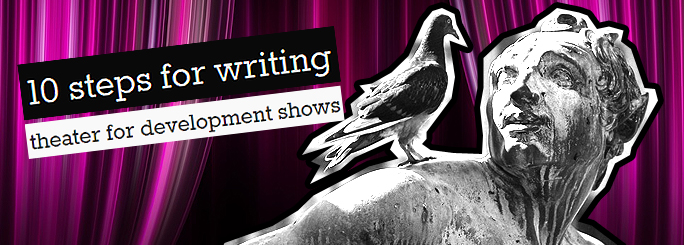
Perhaps the theater is not revolutionary in itself; but have no doubts, it is a rehearsal of revolution!
Augusto Boal, founder of Theater of the Oppressed.
What is theater for development?
Theater for development is a drama-based dialogical process, where theater is practiced as a way of changing behaviors, empowering communities, and encouraging them to voice and solve their own problems.
Within this premise, different approaches use theater for development including theater for, by, and with the people. In theater for the people, the conductor controls the process and presents a finished product to the audience while, in theater by the people, the public will assume control of the process.
Theater with the people offers interesting communication opportunities, as participation and collaboration between actors and audiences is guided, but leaves wide space for improvisation and participation.
To facilitate actors interact with the public and let the public participate to adapt, change, or correct the play, you have to write a consistent plot, solid enough to address the problem you want to show, but flexible enough to be used as a safety net for improvisation.
Okay, so is this about writing scripts for improvisation?
Forget about writing a full hermetic script. Instead of that, use an orienting and inspiring step outline scheme. Even if you are just writing a simple guide, follow common sense rules:
1. Write down the needs, the objective, and the main goals
Know and understand the specificity of the context where you will perform the drama.
Use both observation and research techniques to draft what are the main needs to address during the show. Using active listening, empathy, and deductive reasoning, you will be able to gain a glimpse of the audience’s needs.
Write a simple half page document stating what needs must be addressed, how these needs should be answered from your objective, and list what will be the main goals from your activity to achieve.
2. Develop a simple scheme to help the drama conductor assess the audience’s needs
Before every show and during the needs assessment phase, the drama conductor, the lead actor in charge of engaging the audience, will talk with the audience to identify their specific needs, mood, and willingness to participate.
Write a simple document to help her/him:
- Identify and react to the challenges presented to the audience before, during, and after the show.
- Ask open, pertinent, and stimulating questions in order to encourage audience´s participation.
- Observe audience emotions and be sensitive to them.
- Know how to maintain order, discipline, and respect of others during the play.
- Ensure that the show uses humor and good communication to keep the audience engaged.

3. Be aware of the production process and what resources will be needed
Plan your stage setting and how the crowd will react to your show. Will you perform the play in a known setting? Will it be a fixed settlement or will it be a marching show? Will it be improvised? How many people will you expect to attend the show? What will the audience do before, during, and immediately after the show?
No question that sensitive matters like those related to local culture, gender, ethnicity, or disabilities should be planned in advance.
Do not let the setting or the audience ruin your performance because you didn’t plan unexpected variables.
- The environment in which the show will be performed.
- The sociocultural and security environment.
- The required facilities and tools you may need to run the show.
Keep in mind simplicity. The play must be performed using simple elements that eventually can be found anywhere. Use simple stuff to identify the different characters: a blanket, a scarf, or a simple t-shirt can be multipurpose materials when used creatively.
4. Adjust your plan to the specific format of participatory theater
Plan a warm-up session and an introduction to help and motivate the audience before the performance. Above all, remember that the show must be interesting, engaging, and highly fun. If you forget these basics, you will resoundingly fail.
So, do not reinvent the wheel. Use an Aristotelian structure for your plot: introduction, conflict, climax, and denouement. As simple as that, yep, as complex as that.
Use cause-effect narrative: Every action must be caused by a clear situation and the conflict must come from these situations naturally. Do not force the plot because of narrative needs.
Keep it real (even if you are writing about dragons): build active characters, credible situations, and easy to understand conflicts.
Be comprehensive: Use narrative redundancy as much as you can. Be sure the audience understands the message by delivering it clear and simple over and over again.
Then, review if your message is understood and invite your audience to participate. Finally, evaluate the show and adjust for the next one.
5. Write a step outline
At first stage, during the needs assessment, you have defined your tactical idea (the moral, the values, or the behavior you want to communicate to your audience). Then, you have taken into account the specifics of your project and the tools you will have when performing. Now, it is time to develop the dramatic idea: the plot, the story you want to tell your audience.
Start with the basics: Write words, think in actions. The step outline is not a formal script, but a list of instructions to perform a living experience.
Information must be visually explicit and redundant. Your step outline should be a plot description containing:
- A scheme of structure divided by acts (introduction, conflict, climax, and denouement).
- The turn up points that make your play progress from one act to the next one.
- A description of every scene (one to two sentences) defining what the contribution of each one is.
That’s all. As mentioned above, as simple and complex as that. The following questions should be easily answered after reading your outline:
- Who are the characters?
- What are they looking for?
- What problems are they facing?
- How the story ends?

6. Write tridimensional characters
Develop characters that resemble the target audience. The audience should feel that the characters are just like them so, try to make them touchable and credible.
Start defining your characters attending to their interest, position, and transformation process:
- Define what the character’s interest is: What s/he wants. Why is so important for her/him?
- Define what the character’s position is: What are the tools s/he uses to accomplish her/his interest?
- Define how the character’s transformation is: What will be the steps to achieve her/his interest using her/his positions?
If you need a template, roles on Theater for Development are commonly based in three main models:
- Positive: Those who face the exposed topic and achieve the desired result.
- Negative: Those who don’t respond in the desired way and have to face the consequences.
- Transitional: The central figures representing the audience: Those tempted by the negative or wrong behavior, finally showing the advantages of choosing the positive model realistically.
7. Develop audience’s participation rules
Above all, ensure there’s consistency among the characters, the story, and the context. The public must feel being represented, engaged, and inspired by these three elements.
Improvisation should be encouraged, but not forced. The public must empathize with the main character (the hero) to be implicated in her/his conflict and be concerned about the development of the drama.
8. Design monitoring and evaluation scorecards
Ensure that the information transmitted through the actors and audience interventions is relevant and objective-focused.
Develop an evaluation scorecard to be filled out by the drama conductor. The evaluation scorecard should provide the questions to ask the audience and assess the grade of knowledge the audience have over the shown topics. This evaluation form must cover from general subjects to specific matters related to the case.

9. Write a transmedia planning protocol
Depending on the context and disposable tools, you can take advantage on transmedia planning: plan how you will record or share real time video; how you will use social media before, during, and after the event; how will you take advantage of audio for both external and internal audiences.
Transmedia must be seeing as an opportunity to extend your project: train new actors, engage external audiences, motivate donors, interest the media, or simply document the show.
10. Plan your show structure
To best fit the mixed technique between writing a script-based and improvisation show proposed here, this structure proposal will let you make the most from these ten steps:
- 1. Needs assessment: The conductor assess the audience needs.
- 2. Warm-up: The conductor motivates the audience through songs or dance.
- 3. Introduction: The conductor explains the purpose and objective of the show.
- 4. Performance: The actors perform the show.
- 5. Evaluation and summary: The conductor evaluates if the goals are accomplished.
- 6. Feedback and audience performance: Both, actors and audience, perform the show.
- 7. Conclusions: The conductor summarizes the show and conducts a final assessment.
To see how these steps should be implemented from a practical angle, read how to structure a theater for development show and not die trying. But, before that: What do you think? What’s your approach for writing theater for development? Do you have any tips to improve these ideas?
References:
Creating characters: Participatory Theater for Conflict Transformation Training Manual
http://dmeforpeace.org/sites/default/files/Participatory-Theater-Manual-EN.pdf


